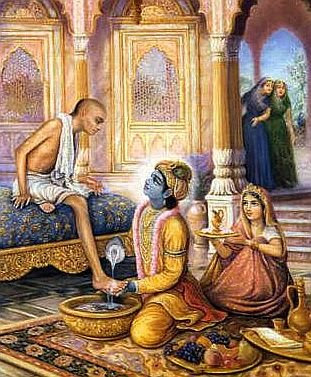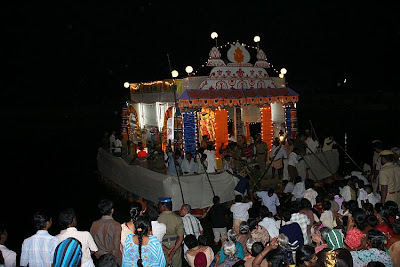I am reproducing below a narrative compiled by William Forbes that explains the mythology of Shivaratri and also the grand association of the Pashupatinath (Lord of Animal Life) Temple at Kathmandu, Nepal. For more information about Shivaratri -- The Eternal Festival and more about this Temple, check out this earlier posting. To find out more about Shivaratri and also specifically how it is celebrated at other significant Shiva stalams, read on.
"This year, on the 23rd of February, Mahashivaratri is celebrated throughout India, Nepal, and the world, by devotees of Lord Shiva. Mahashivaratri means "the great night of Shiva". It is celebrated on the 14th night of the waning moon, (the dark moon night before the new moon), during the month of Phalgun. There are a number of legends connected with the origin of Shivaratri. One is that Goddess Parvati and Lord Shiva were married on this day.
This is also the day that Lord Shiva appeared as a luminous Jyotirlingam before Brahma and Vishnu. All the twelve Jyotirlingams of Bharat (India) are said to have manifested on this day.
 Jyotir Lingam Stalams
Jyotir Lingam Stalams
The Shiva Purana relates a story of Maha Shivaratri's glory –
In ancient times, a Bheel (forest inhabitant) named Gurudruha trudged through a forest to hunt deer. At night, without having sighted a single animal, he climbed a Bilva (Aegle marmelos) tree on the banks of a lake. Later at night, a doe arrived to drink water. Gurudruha aimed his bow and arrow at her. While aiming, he unknowingly dropped some Bilva leaves and his drinking water below on a Shivalingam that happened to be under the tree. The deer then requested him to allow her to entrust her fawns to her husband, after which she would return. After much haggling he agreed.
While awaiting her return, he stayed awake by aimlessly plucking leaves and dropping them below. Again they fell on the Shivalingam. Thus he unknowingly performed its puja (worship) while remaining awake all night. Finally the doe returned with her family, She informed him that along with her, he'd have to kill her family too. As he aimed, some more leaves fluttered down on the Shivalingam.
The collective punya (spiritual merit) accrued from the puja performed unknowingly, eradicated all his sins. This purified his heart. Repenting his flawed life of sin, he set the deer free. As he sat repenting, Lord Shiva manifested in front of him and granted him a boon, "You shall be born in a town known as Shrungver, as a man named Gruha. Lord Vishnu will grace your home as Lord Rama and redeem you." (This event is described in the Ramayana.) Shiva also blessed the deer, which attained a better destiny.
On this day it is easy to please Lord Shiva by fasting and prayer. The main prayer is usually conducted during the night. Ever three hours the devotee worships Lord Shiva in the form of a Shiva Lingam. the Lingam is bathed with milk, ghee, honey, curd, rose water, etc. Lord Shiva is also greatly pleased by the offering of Bilva leaves. One also devotes time to chanting the Vedic Rudram, or the five-syllable mantra of Shiva - Om Namah Shivaya - and to meditating on Him, by remembering one's ultimate goal, which is God Realization, the purpose of human birth. Ascending to the top of Mount Kailash within oneself, and trying to experience the presence of God Shiva within as one's very own self, and simultaneously as the Universal Self permeating the entire universe, one draws close to Lord Shiva. on this night.
For more than a week before and after Shivaratri, the area around Pashupatinath Temple is transformed into a mammoth fair of sorts, with food stalls, pavement markets and clusters of temporary shelters where life-styles and human activities of a mind-boggling variety can be witnessed. Colorful costumes of the many different ethnic and tribal pilgrims from India sporting intriguing headgear, ranging from turbans to towels around the scalp; long flowing dresses, pantaloons and loin cloths, along with the women's colorful sarees, all form a fascinating contrast to the many Sadhu-Babas and Yogis in their birthday suits. People fill the roads - holy men, some half clad, some covered in ash but entirely nude; pilgrims in their distinct and colorful tribal costumes; vendors selling practically everything from vermilion powder, Rudraksha beads, monkey nuts, to Coca Cola and snacks. Foreign tourists also form part of this vast collection of humanity.

Pashupatinath Temple, Katmandu, Nepal
During Shivaratri, the temple of Pashupatinath, dedicated to Lord Shiva, becomes all spruced up in anticipation of the arrival of Sadhus, Yogis and other holy men as well as the hundreds of thousands of devout Hindu pilgrims. All devout Hindus believe that a visit to the holy Pashupatinath temple will absolve them of all past sins and the preference to make this pilgrimage during the time of Shivaratri, and assure them of a good human birth in their next life.
Hindu sadhu burns cowdung cakes to perform some holy rituals in the revered Pashupati area in Kathmandu. Hundreds of devotees from different parts of Nepal and India have been coming to the area to celebrate Maha Shivaratri festival that falls on February 23rd.

On the day of Mahashivaratri, people gather on the hillside across the river from the Pashupatinath temple as well as around the vicinity of the temple complex in groups around campfires and in makeshift shelters, singing Bhajans, reciting Sanskrit verses, discussing various religious topics while maintaining a fast and a vigil in anticipation of the religious ceremonies. Marijuana smoking mendicants, many with long matted tresses, dot the area, serene and trance-like, emulating Lord Shiva himself, in their consumption of the sacred herb, either by smoking it in clay chillum pipes, or by eating bhang.
At midnight Shivaratri festival officially begins with the priests inside the main temple making offerings of the auspicious Pancha Amrit to the Lingam of Lord Shiva. All day and throughout the night, devotees in an almost never-ending stream, file through the gates of the main temple to sprinkle milk, flowers, coins and rice offerings on the Lingam of Lord Shiva to be followed by a ritualistic bath in the river every few hours as dictated by the rituals.
At about six o'clock in the morning priests start the recitation of sacred texts which can be heard for miles around being amplified through loud-speakers strategically spread all over the Pashupatinath temple complex. This chanting of prayers continues till mid-day followed by the singing of Bhajans. The mammoth turnout of pilgrims is such, that devotees and believers are still involved in the elaborate religious activities many days after the actual night of fasting. As is inevitable after a period of fasting, there is the ritual partaking of food and sweetmeats following the festivities of Shivaratri. Naturally there are vast numbers of food-stalls selling many varieties of food and sweets.
 Sadhus
Sadhus
For the devout Hindus who come from far away to experience the Shivaratri festivities and take a dip in the holy waters of the Bagmati river, it is often a once-in-a-lifetime experience.
For non-Hindus, Shivaratri offers a fascinating insight into a very important religious event as well an opportunity to see diverse cultures, peoples and costumes with the most gawked at and photographed being the Hindu holy men - the Sadhus and Yogis, smeared in ash, their foreheads striated with many different and intriguing designs under many different types of hair-do. Completely naked ascetics, with rings in their genitals roam through the crowds, mindless of the stares and glances and to the intense cold of the Himalayan winter, having mastered their minds to withstand the heat, cold and inhibition of all types."



















































